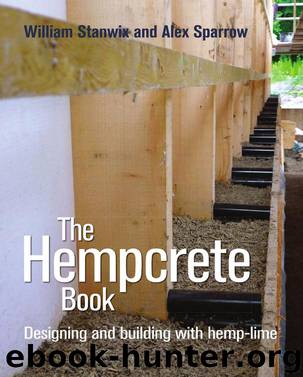The Hempcrete Book: Designing and building with hemp-lime by Alex Sparrow William Stanwix

Author:Alex Sparrow, William Stanwix [William Stanwix and Alex Sparrow]
Format: epub
ISBN: 9780857841223
Publisher: Perseus Books, LLC
Published: 2014-11-11T16:00:00+00:00
Testing the mix
1. Squeeze some hempcrete into a ball.
2. Push a gloved finger into it.
3. If it breaks cleanly, then it is ready.
With a pan mixer, the mixing team typically includes two people: one organizing the materials and feeding the mixer, and another below operating the chute, i.e. filling tubs and handing them to a team of people ferrying them to the ‘tampers’, who are placing the mix into the shuttering. Once each tub has been emptied into the shuttering, the ferrying team returns the empty tubs to the mixer to be refilled and brought back, or to wait for the next mix. However, it may be possible for one experienced person to operate the mixer alone, and this is certainly possible if it has a built-in water tank, automating the process of measuring and adding water.
The quantity produced with an 800-litre pan mixer will be (depending on the exact quantities used) around 0.4m3 per mix. This of course takes a while to produce, given the mixing time, the physical work involved in feeding the mixer, and the time taken to empty it into 30-litre or 45-litre Gorilla Tubs (the 30-litre type is more useful, as everyone can carry them) before a new batch can be started. It is important at first to give your mixing team time to get used to the process, so start slowly: with hempcrete, getting it right is always more important than getting it done quickly.
Once you are used to the process, you will work out a general rule of thumb for the quantity of mix you can knock out in a normal working day, but remember that the mixing speed depends on a lot of other factors as well, such as other people needing to use the telehandler, and the distance that the ferrying team have to walk to empty the tubs. Ultimately, of course, the mixing speed has to match the speed that the placing team can work at, which can vary around different parts of the frame (placing slows down around corners and openings, and also relies on the shuttering being moved on ahead), as you don’t want tubs of mix sitting around drying out or getting rained on. In any case, you need the tubs back to keep emptying the mixer, unless you want to invest in more than 25 tubs.
We return to this subject in Chapter 19, but for now, the point to remember is that finding the balance between the speed of mixing, ferrying and placing hempcrete is important. The balance needs to be constantly monitored and readjusted as necessary, in order that the operation is run efficiently and maximum productivity is achieved.
Download
This site does not store any files on its server. We only index and link to content provided by other sites. Please contact the content providers to delete copyright contents if any and email us, we'll remove relevant links or contents immediately.
| Acoustics | Bridges |
| Earthwork Design | Environmental |
| Fire Science | Highway & Traffic |
| Hydrology | Remote Sensing |
| Seismic Design | Structural |
| Structural Dynamics | Surveying & Photogrammetry |
| Transportation |
Whiskies Galore by Ian Buxton(41716)
Introduction to Aircraft Design (Cambridge Aerospace Series) by John P. Fielding(33014)
Small Unmanned Fixed-wing Aircraft Design by Andrew J. Keane Andras Sobester James P. Scanlan & András Sóbester & James P. Scanlan(32682)
Craft Beer for the Homebrewer by Michael Agnew(18079)
Turbulence by E. J. Noyes(7891)
The Complete Stick Figure Physics Tutorials by Allen Sarah(7261)
Kaplan MCAT General Chemistry Review by Kaplan(6818)
The Thirst by Nesbo Jo(6751)
Bad Blood by John Carreyrou(6472)
Modelling of Convective Heat and Mass Transfer in Rotating Flows by Igor V. Shevchuk(6352)
Learning SQL by Alan Beaulieu(6156)
Weapons of Math Destruction by Cathy O'Neil(6080)
Man-made Catastrophes and Risk Information Concealment by Dmitry Chernov & Didier Sornette(5874)
Digital Minimalism by Cal Newport;(5580)
Life 3.0: Being Human in the Age of Artificial Intelligence by Tegmark Max(5402)
iGen by Jean M. Twenge(5320)
Secrets of Antigravity Propulsion: Tesla, UFOs, and Classified Aerospace Technology by Ph.D. Paul A. Laviolette(5234)
Design of Trajectory Optimization Approach for Space Maneuver Vehicle Skip Entry Problems by Runqi Chai & Al Savvaris & Antonios Tsourdos & Senchun Chai(4953)
Electronic Devices & Circuits by Jacob Millman & Christos C. Halkias(4861)
